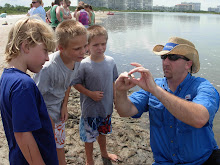
Yesterday I took a group of students from Edison State College to Keewaydin Island in Naples to discuss barrier island ecology. Once we made it to the beach the students had a great time exploring the shoreline, especially the wrack line. Although you may not be familiar with this term, I'm sure you've searched through and near it looking for whatever "beach treasures" enticed you.
Wrack lines are linear piles of marine debris (both natural and manmade) that gets washed up on the beach from the tides. Typical debris includes uprooted seagrasses, algae, seeds, mangrove leaves and propagules, along with sponges, soft corals, shells, egg cases, and worm tubes. Unfortunately, the wrack line is also often a reminder that human-based marine debris has become a common site in the marine environment; plastics, fishing gear, cigarette butts, and drift wood are common finds. Regardless, the wrack line is an important part of the beach ecosystem.The size and duration of the wrack line can vary depending on storm activity, winds, and tide conditions. Once established,the wrack line provides shelter for a variety of animals such as insects, crabs, and amphipods. They in turn serve as a food source for a variety of animals including shorebirds and/or raccoons. The organic material within the wrack line also provides critical nutrients to dune vegetation, and helps to stabilize shifting beach sands so new dunes can form. In many coastal communities, the wrack line is raked and removed to provide a more "aesthetic" beach scene for tourists and residents.
 |
| egg cases attached to a fighting conch shell |
 |
| A lightning whelk egg case found among the wreck line |
 |
| A wreck line on Keewayding Island |
 Yesterday I took a group of students from Edison State College to Keewaydin Island in Naples to discuss barrier island ecology. Once we made it to the beach the students had a great time exploring the shoreline, especially the wrack line. Although you may not be familiar with this term, I'm sure you've searched through and near it looking for whatever "beach treasures" enticed you.
Yesterday I took a group of students from Edison State College to Keewaydin Island in Naples to discuss barrier island ecology. Once we made it to the beach the students had a great time exploring the shoreline, especially the wrack line. Although you may not be familiar with this term, I'm sure you've searched through and near it looking for whatever "beach treasures" enticed you.






No comments:
Post a Comment